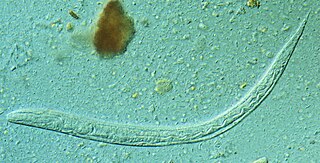
Strongyloides stercoralis is a human pathogenic parasitic roundworm causing the disease strongyloidiasis. Its common name in the US is threadworm. In the UK and Australia, however, the term threadworm can also refer to nematodes of the genus Enterobius, otherwise known as pinworms.

Procyon is a genus of nocturnal mammals comprising three species commonly known as raccoons in the family Procyonidae. The most familiar species, the common raccoon, is often known simply as "the" raccoon, as the two other raccoon species in the genus are native only to the tropics and are less well known. Genetic studies have shown that the closest relatives of raccoons are the ring-tailed cats and cacomistles of genus Bassariscus, from which they diverged about 10 million years ago.

Helminthiasis, also known as worm infection, is any macroparasitic disease of humans and other animals in which a part of the body is infected with parasitic worms, known as helminths. There are numerous species of these parasites, which are broadly classified into tapeworms, flukes, and roundworms. They often live in the gastrointestinal tract of their hosts, but they may also burrow into other organs, where they induce physiological damage.

Baylisascaris is a genus of roundworms that infect more than fifty animal species.

Helminthic therapy, an experimental type of immunotherapy, is the treatment of autoimmune diseases and immune disorders by means of deliberate infestation with a helminth or with the eggs of a helminth. Helminths are parasitic worms such as hookworms, whipworms, and threadworms that have evolved to live within a host organism on which they rely for nutrients. These worms are members of two phyla: nematodes, which are primarily used in human helminthic therapy, and flat worms (trematodes).

The Cozumel raccoon is a critically endangered species of island raccoon endemic on Cozumel Island off the coast of the Yucatan Peninsula, Mexico. It is sometimes also called the pygmy raccoon, dwarf raccoon, Cozumel Island raccoon, and Cozumel raccoon bear.

Helice tridens is a species of crab which lives on mudflats around the coasts of Japan and the Korean Peninsula.
Brachylaima virginianum is a fluke of the genus Brachylaima that infects the Virginia opossum throughout its range. It has also been found in young black bears and in marsh rice rats, both from Florida., and from raccoons in Kentucky.
Falcaustra tannaensis is the 87th discovered species of the nematode genus Falcaustra. It has been identified in geckos from Tanna Island, Vanuatu. Species of Falcaustra have been known parasites that occur in the digestive tracts of fish, amphibians, and mammals. Until 2010, none had ever been identified in the South Pacific Islands.
Microphallus turgidus is a widespread and locally common flatworm parasite in New Zealand lakes and streams. Multilocus allozyme genotype data show that Microphallus turgidus is a single outbred species with high levels of gene flow among South Island populations. Microphallus turgidus is commonly found in the abdominal muscles of grass shrimp.

Microcotyle is a genus which belongs to the phylum Platyhelminthes and class Monogenea. Species of Microcotyle are ectoparasites that affect their host by attaching themselves as larvae on the gills of the fish and grow into adult stage. This larval stage is called oncomiracidium, and is characterized as free swimming and ciliated.
Oochoristica is a genus of tapeworms.
Strongyloides lutrae is a parasitic roundworm infecting the small intestine of the otter, Lutra canadensis. It was first described from Louisiana.
Strongyloides dasypodis is a parasitic roundworm infecting the large intestine of the armadillo, Dasypus novemcinctus. It was first described from Louisiana.
Strongyloides ardeae is a parasitic roundworm infecting the small intestine of yellow-crowned night heron, Nyctanassa violacea, and eastern green heron, Butorides virescens. It was first described from Louisiana.
Strongyloides physali is a parasitic roundworm infecting the large intestine of the Gulf Coast toad. It was first described from Louisiana.
Strongyloides serpentis is a parasitic roundworm infecting the intestine of the green water snake, hence its name. It was first described from Louisiana.
Strongyloides gulae is a parasitic roundworm infecting the esophagus of the green water snake, as well as eight other species of snakes. It was first described from Louisiana.
Simplicimonas similis is a species of parabasalid.







